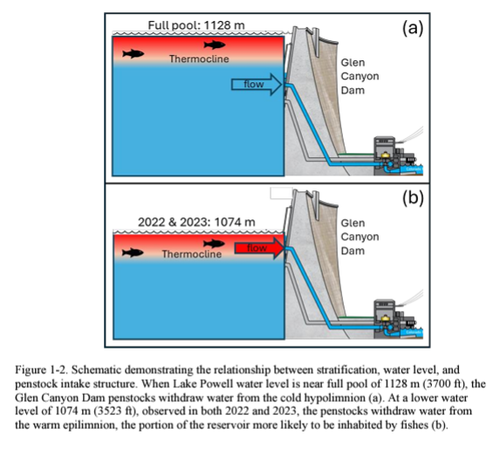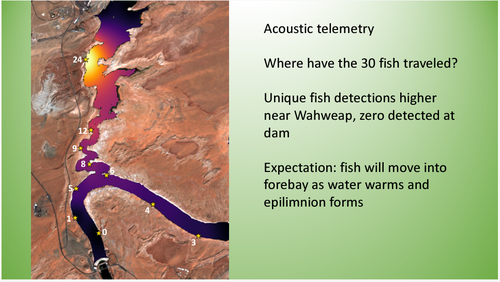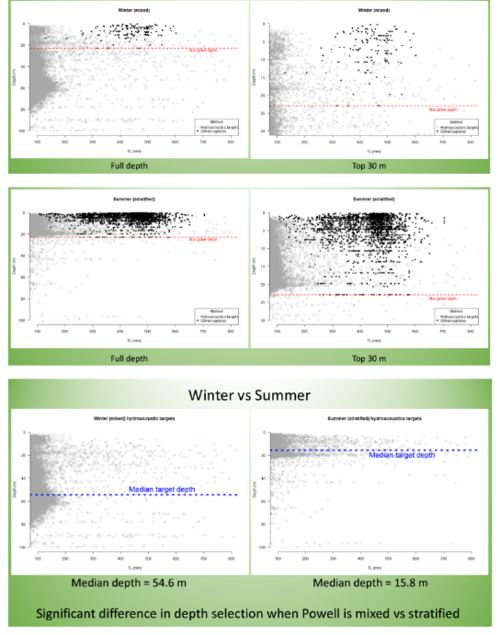Difference between revisions of "Entrainment"
Cellsworth (Talk | contribs) |
Cellsworth (Talk | contribs) |
||
| Line 26: | Line 26: | ||
==Entrainment of warmwater nonnative fish through Glen Canyon Dam== | ==Entrainment of warmwater nonnative fish through Glen Canyon Dam== | ||
| − | + | Winter: reduced entrainment risk, bass are in shallower warmer water like in Wahweap Bay. <br> | |
| + | Summer: higher entrainment risk, bass are found in the forebay | ||
| − | + | Lower reservoir elevations: higher entrainment risk, bass are found nearer to the penstock withdrawals | |
| − | + | *3543 ft at the 5th percentile | |
| − | + | *3621 ft at the 95th percentile [https://digitalcommons.usu.edu/cgi/viewcontent.cgi?article=1304&context=etd2023] | |
| − | + | ||
| − | + | ||
|}<!-- | |}<!-- | ||
| Line 49: | Line 48: | ||
|- | |- | ||
|style="color:#000;"| | |style="color:#000;"| | ||
| + | |||
| + | When the reservoir was cold (<10 °C) and well-mixed, most fishes selected gently sloping habitat such as that found in Wahweap Bay (5 km from GCD), and thus winter entrainment risk is low for most species. When the reservoir was stratified (>20 °C surface temp.) fish were active in the forebay epilimnion within meters of the dam, increasing entrainment when the dam penstock is positioned within the epilimnion, as it was during our study, rather than below the thermocline when the reservoir water level is higher. | ||
| + | |||
| + | Smallmouth Bass Micropterus dolomieu) may survive entrainment at rates above 50% at low water levels, with survival expected to decrease as the water level rises, but remaining problematically high across all water levels where entrainment is expected. Other fishes may survive entrainment at higher rates, depending on physiology. | ||
| + | |||
| + | Minimizing successful nonnative fish passage through GCD is best achieved through maintenance of water levels higher than those in 2022 and 2023, which would decrease both entrainment and survival of entrainment. [https://digitalcommons.usu.edu/cgi/viewcontent.cgi?article=1304&context=etd2023] | ||
| + | |||
| + | |||
| + | |||
| + | The depth of the epilimnion in the Forebay varies annually as a function of spring runoff, a suite of environmental factors (e.g., Boehrer and Schultze 2008), and water management. Consequently, the minimum reservoir elevation necessary to prevent entrainment of epilimnetic water and associated biota will vary among years and will likely require an adaptive management framework (Williams 2011). Based on this study, minimum reservoir elevations necessary to limit epilimnetic entrainment in 2022 and 2023 were 1083 m (3552 ft) and 1096 m (3594 ft), respectively. | ||
| + | |||
| + | Notably, in both years, the actual reservoir elevation was below these minimum thresholds, indicating that epilimnetic entrainment of some nonnative fishes was possible during portions of both years. A recent study suggested that a minimum water level of 1088 m (3570 ft) would limit Smallmouth Bass entrainment based on analysis of historical captures below GCD (Eppehimer et al. 2024). | ||
| + | |||
| + | Considering the full likely range of depth to thermocline (5th to 95th percentiles of USGS historical time series), we suggest avoiding epilimnetic entrainment requires a reservoir water level between 1080 m (3543 ft) at the 5th percentile and 1104 m (3621 ft) at the 95th percentile (note: as this range is based on historical context, it is valid for a stationary climate, and may shift or expand under nonstationarity). These elevations translate to a substantial difference in water storage, with storage of 10.1 km3 (8.2 M acre-ft) at 1080 m elevation, increasing roughly 75% to 17.9 km3 (14.5 M acre-ft) at 1104 m elevation (Jones and Root 2022). The degree of water storage required to maintain higher water elevations and limit epilimnetic entrainment has broadscale implications with respect to water supply and hydropower generation in the Colorado River Basin that are beyond the scope of this study. [https://digitalcommons.usu.edu/cgi/viewcontent.cgi?article=1304&context=etd2023] | ||
[[Image:Forebay_telemetry.png|thumb|center|500px| ]] | [[Image:Forebay_telemetry.png|thumb|center|500px| ]] | ||
Revision as of 12:57, 27 February 2025
|
|
Entrainment of warmwater nonnative fish through Glen Canyon DamWinter: reduced entrainment risk, bass are in shallower warmer water like in Wahweap Bay. Lower reservoir elevations: higher entrainment risk, bass are found nearer to the penstock withdrawals
|
| -- |
-- |
-- |
|---|
|
|


